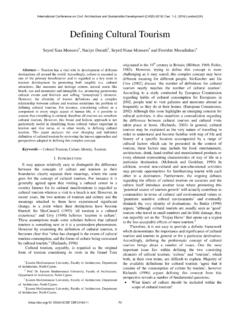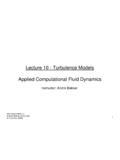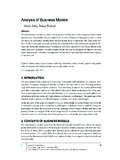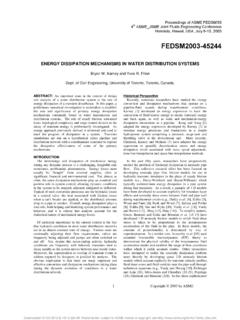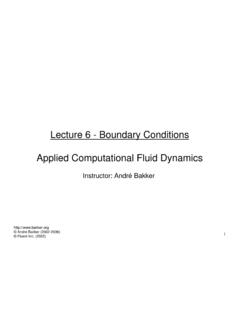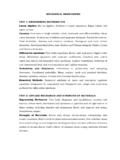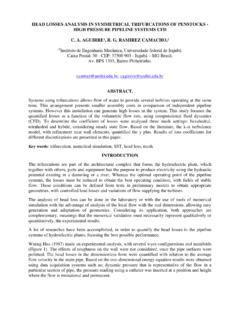Transcription of Comparison of Sound Power Prediction Models of Wind Turbine s
1 International Conference on Advances in Agricultural, Biological & Environmental Sciences (AABES-2014) Oct 15-16, 2014 Dubai (UAE). Comparison of Sound Power Prediction Models of Wind Turbines Eman Zidan, Tamer Elnady, and Adel Elsabbagh This will help urban planners assess the noise impact of new Abstract----Noise of the turbines is a major consideration in wind farms. determining the acceptance of a wind farm planning application. In In this study, different wind Turbine noise types are defined, this study, the wind Turbine noise sources are presented and and their predictive Prediction methodologies and their input discussed with the different noise Prediction Models . The technical parameters are introduced. characteristics of the Turbine model used in this study are defined and used as the input data for the different Models . The resulted II. NOISE SOURCES OF WIND TURBINES. values from the Models have been investigated and an approach for predicting the Sound Power of wind turbines is proposed in this The noise emitted from wind turbines can be classified to paper.
2 The results show that the used model should be decided two types of sources: Mechanical noise which is generated according to the parameter inputs available for the Turbine model from the relative motion of the machinery components of the and also according to the accuracy level needed for the study. Turbine , and aerodynamic noise which is caused by the air flow around the blades. Keywords Acoustics, Aerodynamics noise sources, Noise modeling, wind Turbine . A. Mechanical noise The main sources of the mechanical noise are mainly the I. INTRODUCTION. gearbox and generator. The noise emitted from gearbox is R ENEWABLE energy comes from natural resources such as sunlight, wind, rain, and geothermal heat, which are renewable. Globally, the long-term technical potential of structure-borne and air-borne noise, while the noise of the generator is considered only air-borne noise. This is beside the noise emitted from the hub, the rotor and the tower which wind energy is believed to be five times total current global can transmit the machinery noise.
3 Energy production. Wind turbines can be a great way to Table 1 represents the Contribution of individual utilize the wind energy to convert it into usable electricity. components to the total Sound Power level of a 2MW wind This could require wind turbines to be installed over large Turbine which reported by Pinder [1]. areas, particularly in areas of higher wind resources. Utilizing the winds energy with a wind Turbine can provide a source of TABLE I. Sound Power LEVELS OF MECHANICAL NOISE OF A 2MW EXPERIMENTAL [1]. clean and renewable electricity for large or small communities. Wind turbines can be installed as single Sound Power level Air-borne or Element (dB(A)) structure-borne installations or as part of a wind farm. Some wind farms are Gearbox Structure-borne capable of providing the entire electricity supply for large Gearbox Air-borne villages or small towns and are most effective on high ground Generator Air-borne where the wind speed is generally higher and more constant Hub(from gearbox) Structure-borne Blades(from gearbox) Structure-borne than at lower levels.
4 Tower(from gearbox) Structure-borne The purpose of this study is to develop an approach of Auxiliaries Air-borne calculating the Sound Power emitted by wind Turbine blades. B. Aerodynamic noise This is done through studying the different sources of noise in The wind Turbine aerodynamic noise is very important to wind turbines and the Models predicting their Sound Power . be investigated because of its high emission levels in addition to the difficulty of its control compare with the mechanical noise. The aerodynamic noise can be classified to three types Eman Zidan from the Group for Advanced Research in Dynamic Systems (ASU-GARDS), ASU Sound & Vibration Lab, Faculty of Engineering, Ain of sources: Shams University, Cairo, Egypt (phone: +20 122 6687374; e-mail: 1. Low-Frequency Noise, caused by the wind speed change passing through the blades with the tower presence. The most Tamer Elnady from the Group for Advanced Research in Dynamic Systems (ASU-GARDS), ASU Sound & Vibration Lab, Faculty of Engineering, Ain common designs of wind turbines nowadays are upwind Shams University, Cairo, Egypt.)
5 (phone: +20 122 3101116; e-mail: designed which has a reduced effect from the tower compare with the downwind type. The low frequency noise becomes Adel Elsabbagh from the Group for Advanced Research in Dynamic Systems (ASU-GARDS), ASU Sound & Vibration Lab, Faculty of Engineering, Ain not an important noise source when the A-weighting filer is Shams University, Cairo, Egypt. (phone: +20 100 9205975; e-mail: applied to it. 49. International Conference on Advances in Agricultural, Biological & Environmental Sciences (AABES-2014) Oct 15-16, 2014 Dubai (UAE). 2. Turbulent Inflow Noise, caused by the atmospheric Only one parameter is required as an input for this model turbulence and the interacting of the turbulent air with the which is the rated Power of the wind Turbine (PwT) in Watts. Turbine blades. The characteristics of this noise depend on the 2. Hau model [3]: Equation (2) is another Sound Power atmospheric boundary layer characteristics.))
6 Prediction formula developed by Hau. 3. Airfoil Self Noise, occurs even if there is no turbulence LwA = 22log10 D + 72 (2). flow, this noise is caused by the interacting of the air flow with the airfoil surface. The airfoil self noise has a broadband This model requires only the rotor diameter as an input. nature and it has different noise mechanisms which are: 3. Hagg model [4]: Equation (3) is developed by Hagg Turbulent boundary layer trailing edge noise, laminar taking into consideration one more important parameter boundary layer vortex shedding noise, tip vortex formation which is the tip speed at rotor blade (VTip) in m/s. noise, and trailing edge bluntness vortex shedding noise LwA = 50log10 VTip +10log10 D 4 (3). III. NOISE Prediction Models OF WIND TURBINES. The wind Turbine mechanical noise can be reduced by some 4. Another model is developed by Hagg [5] taking into simple mitigation measures such as using quitter gearbox, consideration more parameters of the Turbine characteristics periodic maintenance, changing of some mechanical parts Ab L pA = C1log10 VTip + C 2 log10 ( n B ) + C3 log10 CT.
7 Which can affect the emitted noise. That's why the Ar (4). mechanical noise has been neglected in this study and only D. + C 4 log10 C5 log10 D C6. the aerodynamics has been considered and investigated. r This section investigates some noise Prediction Models of This model has been developed to estimate the overall the different aerodynamic noise types illustrating the required Sound pressure level at a certain distance (LpA). The parameters for each model and how each model can be parameters required for this model are the number of blades implemented. Some of the Prediction Models are simple rules (nB), blade area (Ab), rotor area (Ar), axial force coefficient of thumb for the overall levels, and some require complicated (CT), rotor diameter (D), the distance between the rotor hub inputs and produce the whole frequency range. The different and the observer (r), and a few constants (C1-C6). The values Prediction Models have been classified according to Lowson of these constants are listed in the next section.
8 [2] into three classes. 5. Models introduced by noise propagation software based on real measurements. Many noise propagation software have TABLE II. CLASSIFICATIONS OF THE NOISE Prediction CODES ACCORDING. a Sound emission libraries that provides a pre-measured TO LOWSON [2] Sound Power levels for different type of sources, the library Type of code Description provides a selection of wind Turbine types with specific Predictions giving an estimate of overall level as a simple parameters and their overall Sound Power levels based on Class I actual measurements, these Models can be used as a reference algebraic function of basic wind Turbine parameters for the estimated Sound Power levels of different wind Predictions based on separate consideration of the various Class II mechanisms causing wind Turbine noise, using selected turbines if the basic geometric parameters are known. Table 3. wind Turbine parameters shows the different Models provided by SoundPLAN software Predictions utilizing complete information about the noise for some wind Turbine types at wind speed of 8 m/sec.
9 Class III mechanisms related to a detailed description of the rotor geometry, and aerodynamics TABLE III. SWL OF DIFFERENT WIND Turbine Models BASED ON ACTUAL. Class I Models are rules of thumb giving the overall Sound MEASUREMENTS. Power /pressure levels. These Models require simple input Hub Power Rotor Wind Turbine model dB(A) Height parameters, such as rotor diameter, Power , and wind speed. (kW) Diameter (m). (m). Class II Models estimate the Sound pressure level in a AN Bonus 600 kW/41 600 50 41. frequency broadband and it requires more complicated input DeWind 41 500 40 41. parameters. Class III Models includes more refined Models DeWind 46 600 40 46. describing the noise mechanisms. Up to now, no Models of Enercon E-41 99 500 50 41. this type have been available for implementation. Euroturbine ET 550/41 550 42 Husumer Schiffswerft HSW. A. Class I noise Prediction Models 250 50 250 T. There are four Models for wind Turbine noise Prediction Jacobs Energie GmbH.
10 500 40 37/500. that can be classified as class I category. NEG Micon M 700-225/40. 225 36 1. Lowson model [2]: Equation (1) has been developed by kW. NEG Micon M 750- Lowson as a very simple method to obtain the overall Sound 400/100 kW. 400 53 39. Power level with simple input parameters. NORDEX N29/250 kW 250 50 42. NORDTANK 500/41 500 50 41. SEEWIND 52-750-65 99 750 55 52. LwA = 10log10 PwT + 50 (1). VESTAS V 66 MW 103 1650 60 66. Windtechnik-Nord 200/26 101 200 40 26. 50. International Conference on Advances in Agricultural, Biological & Environmental Sciences (AABES-2014) Oct 15-16, 2014 Dubai (UAE). B. Class II noise Prediction Models M 5 LD St . SPL = 10log S 2 l + B S + K 2 (8). In the following Models , the Turbine blade is divided into St 2 . segments, each segment has its own chord, span, angle of re . attack, free stream velocity, and hence each segment has its Equations (7) & (8) are used when angle of attack own contribution on the total Sound level emitted.
